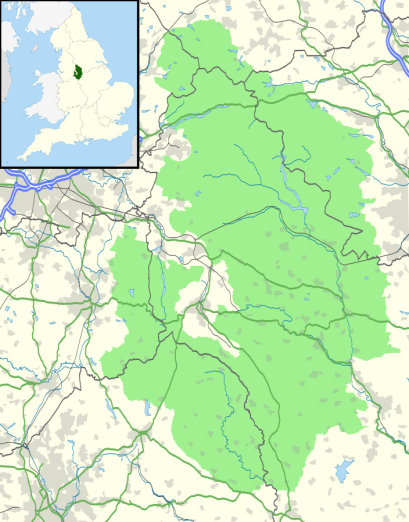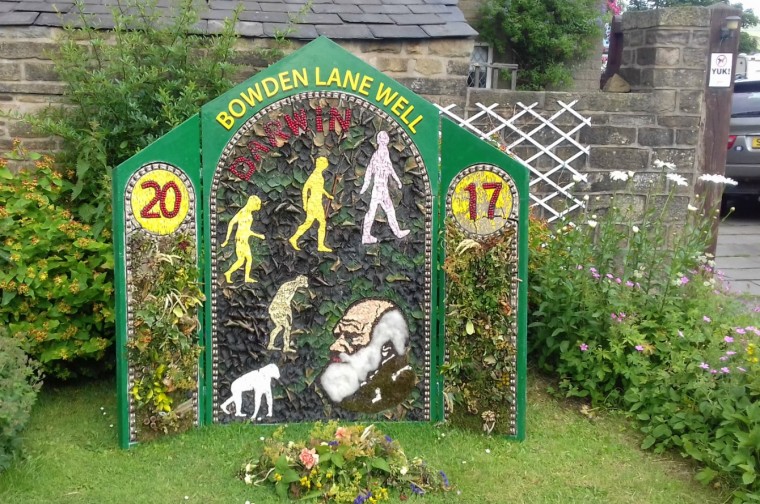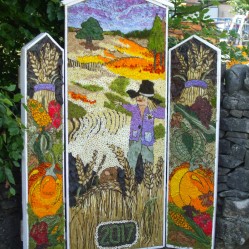Well dressing involves the dressing, or decorating, of wells and springs with flower petals, and, as such, it is sometimes known as well flowering. The custom is an ancient one and seems to be unique to England. It is particularly associated with the limestone villages of the Peak District of Derbyshire and parts of Staffordshire (which I’ll say more about in the next few posts) although one or two other areas also practise the tradition.

The origins of the custom are still uncertain. Some maintain it could have developed from a pagan custom of sacrificing to the gods of wells and springs in order to ensure the continuing supply of fresh water. As many other traditions, it was later adopted by the Christian Church as a means of giving thanks to God for supplies of drinking water. A tradition of well dressing in the Malverns (a range of hills in Worcestershire, Herefordshire and Gloucester) dates from the 12th and 13th centuries.
Some sources hold that the practice began following the Black Death (plague) of 1348-9. A third of the population of England was wiped out at that time, although a few of the villages were untouched.

The people of those fortunate villages attributed their luck to the clean fresh water supply from their wells and started dressing them as a way of giving thanks. Still other people believe the custom arose during a prolonged drought of 1615 when people celebrated their own wells’ reliability. Then there are those who attribute the custom to the time of another plague – the Great Plague of 1665 – during which time many Derbyshire villages, including Eyam, were decimated. Yet some villages had remained untouched, like nearby Tissington, and the people gave thanks at their wells for their deliverance.
Whatever its origins, well dressing seems to have disappeared for some time in most Derbyshire villages, with only a few still celebrating it in the 19th century. The main one of those villages was Tissington, as mentioned by Ebenezer Rhodes in his book ‘Peak Scenery’ in 1835. The custom was introduced in the town of Buxton in 1840 and was recorded as being followed in Wirksworth in 1860. With the arrival of piped water supplies, the tradition was extended to include the dressing of not only wells, but taps, too.
The custom of well dressing rose and fell in popularity over the following years. Then, in the 1930s, the Shinwell family of Tideswell made considerable efforts to revive it. Well dressing has since been restored in many villages and small towns and, throughout the summer months, it is one of the attractions that draws people from all over the world to Derbyshire.
Today, the first well dressings are in May, with Tissington village being the first. Naturally, the flower petals don’t last for long, so the villages follow a regular calendar each year. While we were in Derbyshire last week, we managed to visit four of the five places with newly dressed wells for that week.
Our first view of well dressings was in Buxton, a spa town which has the reputation of having ‘the highest elevation …. of any market town in England’. These are a few ph0tos of the three ‘dressed’ wells in the town:
The next well dressing we visited was in the busy village of Hathersage. (Little John of the Robin Hood stories is said to have been born in Hathersage and buried in the churchyard there.) These are photos of the well we found. The theme of this one, as can be seen on the board itself, is ‘Give Peace a Chance’.
Peak Forest was the third of the well dressing villages we got to. It’s a small village and its one ‘well dressing’ was beside a tap. The theme was a very rural one:
On the last day of our stay in Derbyshire we headed out to the small town of Chapel-en-le-Frith (which translates from the Norman French as Chapel in the Forest). We found seven well dressings here, all with the theme of ‘Famous Britons’. Some had been created by children’s groups.
The construction of a well dressing is a long and skilful process which can take up to ten days. It often involves the whole population of the village. First, wooden frames are constructed and wet clay is spread to a depth of a couple of inches across the wooden backing board. The required design is sketched out on paper and ‘pricked out’ onto the wet clay. The picture is then filled out with natural materials such as flower petal and leaves, entire flower heads, moss, sheep’s wool, wheat or barley straw, berries and nuts e.g. beech nuts, as on the Buxton Children’s well, and even immature fruits like the tiny apples on the Isaac Newton well dressing in Chapel-en-le-Frith. Coloured (or painted) stones, pebbles and gravel are sometimes used, too.
Throughout the well dressing season, some of the villages hold festivals or galas and decorate the streets with colourful and fun models. These are a few we came across in Hathersage:
It was very enjoyable visiting all these wells and looking at how they’re constructed. I think next year we’ll try to get out to Tissington in May. It’s a very quaint village, only a couple of miles from where we were staying, and we met some lovely ‘locals’ there. We’re looking forward to going back.

















































